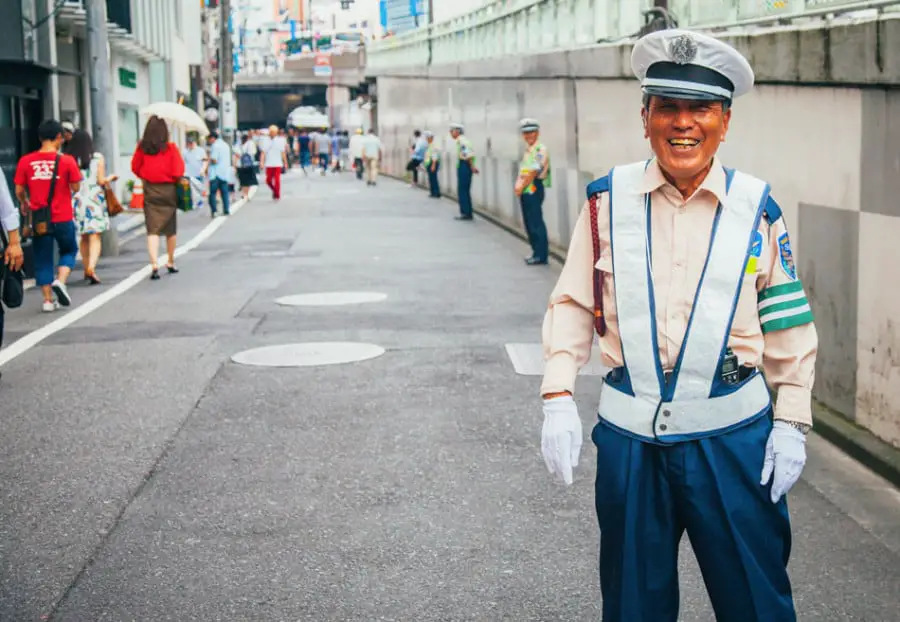Visiting Japan is an enriching experience, but many travelers worry about the costs, especially when trying to stick to a budget. The good news is that there are numerous historic and beautiful temples and shrines you can explore for free. For first-time travelers, visiting these sacred places can be a way to explore the country’s deep history, stunning architecture, and tranquil beauty without spending a dime.
Here’s a list of 13 temples and shrines that are free to visit across Japan. I will also give you useful information about each one, as well as, a pro tip to enjoy it even more.
1. Senso-ji Temple (Tokyo)
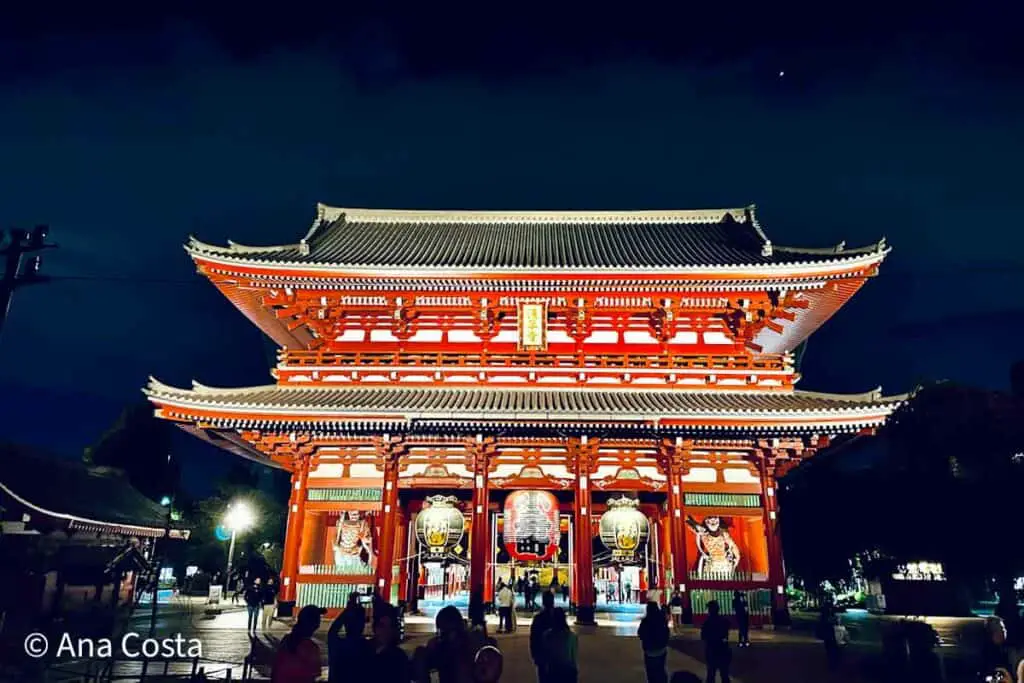
Senso-ji is the oldest temple in Tokyo, and an essential stop in any itinerary due to its historical and cultural significance. After you go through the well-known Kaminarimon Gate, you’ll walk down the famous Nakamise Street. This street is lined with shops on either side that sell local treats and souvenirs. The main hall of the temple and the nearby pagoda are the preferred spots for those visiting for the first time.
- Location: 2 Chome-3-1 Asakusa, Taito City, Tokyo 111-0032, Japan
- Highlights: The giant red lantern at Kaminarimon Gate, the five-story pagoda, and the impressive main hall.
- Entry Fee: Free.
- How to Get There: Take the Tokyo Metro Ginza Line or Toei Asakusa Line to Asakusa Station. The temple is about a 5-minute walk from Exit 1.
- Best Pass: Tokyo Subway Ticket (from ¥800). Buy the Tokyo Subway Ticket here.
- Pro Tip: Arrive early in the morning or late in the evening to avoid crowds and capture photos of the temple without tourists.
- Useful Website: Senso-ji
2. Meiji Jingu Shrine (Tokyo)
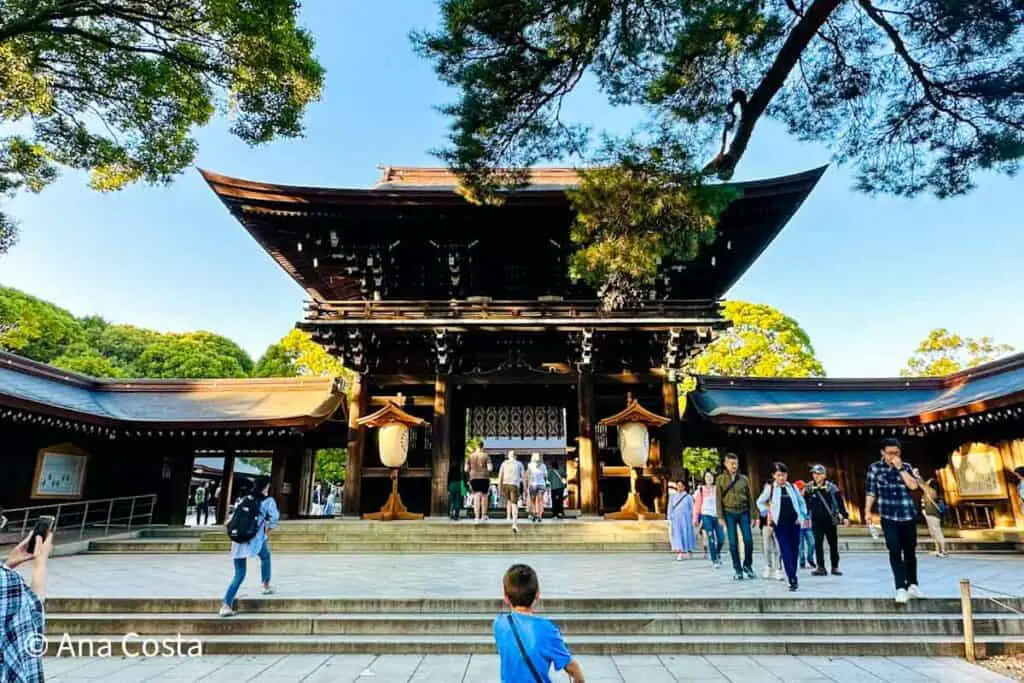
One of Tokyo’s most important Shinto shrines is the Meiji Jingu, located near Harajuku. This shrine is dedicated to Emperor Meiji and Empress Shoken, and it’s a quiet place to escape from the city. Visitors can walk through the quiet forest and look at the big gates called torii. This is also a good place for people who want to learn about Japan’s spiritual and cultural history.
- Location: 1-1 Yoyogikamizonocho, Shibuya City, Tokyo 151-8557, Japan
- Highlights: The massive torii gate, peaceful walking paths, and the serene inner courtyard.
- Entry Fee: Free (The inner garden has a small fee).
- How to Get There: Take the JR Yamanote Line to Harajuku Station, or the Tokyo Metro Chiyoda Line or Fukutoshin Line to Meiji-jingumae Station. The shrine is a 5-minute walk from either station.
- Best Pass: Greater Tokyo Pass (around ¥6,500 for 5 days) – Unlimited train rides on 13 private railway lines in Kanto area and 31 bus companies in Metropolitan Tokyo and three surrounding prefectures. Perfect if you’re exploring Tokyo and the surrounding areas. Buy the Greater Tokyo Pass here.
- Pro Tip: Combine your visit with a stroll through nearby Yoyogi Park for a relaxing break in the city.
- Useful Website: Meiji Jingu
3. Yasaka Shrine (Kyoto)

Located in Kyoto’s Gion district, Yasaka Shrine is one of the city’s most famous Shinto shrines. It is known for its bright vermilion gates (which are striking) and its deep history. Yasaka Shrine plays a major role in Kyoto’s yearly Gion Matsuri festival.
Visitors come to the shrine to see its architecture, walk through Maruyama Park, and experience traditional rituals. This makes it a great place for those who want to explore Kyoto’s cultural landmarks. However, people should also be aware that it can get quite crowded during festival times.
Get all the cool spots and tips for a fun trip to Japan. It's free!
Get My Japan Guide
- Location: 625 Gionmachi Kitagawa, Higashiyama Ward, Kyoto, 605-0073, Japan
- Highlights: Beautiful views at night with lanterns illuminated, especially during festivals.
- Entry Fee: Free.
- How to Get There: Take the Kyoto City Bus (routes 100, 206, or 207) to Gion bus stop. The shrine is right next to the stop.
- Best Pass: Kyoto City Bus & Kyoto Bus One-Day Pass (¥1,100) – Unlimited bus rides in the city for one day.
- Pro Tip: Visit in the evening when the shrine is beautifully lit by lanterns, especially during the Gion Matsuri festival in July.
- Useful Website: Yasaka Shrine
4. Fushimi Inari Taisha (Kyoto)

The well-known Fushimi Inari Taisha is famous for its thousands of red torii gates. The shrine is dedicated to Inari, the Shinto god of rice and prosperity. Visitors come here to have spiritual experiences and enjoy picturesque hiking. It is one of the most photographed spots in Japan, especially for first-time visitors.
Hey, check out these recommendations I have for you!
Before going any further, take a look at some of the recommendations I've handpicked for you. I think these are essential items you should have on your trip to Japan. You can check them out and buy them directly from Amazon.

|

|

|
| A universal travel adapter | A 10,000 mAh power bank | A travel adapter and converter |
- Location: 68 Fukakusa Yabunouchicho, Fushimi Ward, Kyoto, 612-0882, Japan
- Highlights: Hiking through the torii gates up Mt. Inari for stunning views of Kyoto.
- Entry Fee: Free.
- How to Get There: Take the JR Nara Line from Kyoto Station to Inari Station. The shrine is a 5-minute walk from the station.
- Best Pass: JR Kansai Area Pass (from ¥2,800 for 1 day) – Unlimited rides on special rapid services, rapid services, and local trains on JR West lines between Kansai Airport, Kyoto, Osaka, Nara, Wakayama, Kobe, and Himeji. Buy the Kansai Area Pass here.
- Pro Tip: Plan to hike at least part of the way up Mt. Inari to experience the quieter, less crowded parts of the shrine.
- Useful Website: Fushimi Inari Taisha
You may also like:
5. Osu Kannon Temple (Nagoya)
Osu Kannon Temple is a popular Buddhist temple located in Nagoya. The temple is known for its huge red paper lantern and friendly pigeons. Close to the temple, you’ll find Osu Shopping Street, a lively area with many stores. Osu Kannon is a popular spot during local festivals and an excellent stop for those exploring Nagoya.
- Location: 2 Chome-21-47 Osu, Naka Ward, Nagoya, Aichi 460-0011, Japan
- Highlights: The huge red pagoda, monthly flea markets, and nearby shopping.
- Entry Fee: Free.
- How to Get There: Take the Tsurumai Line to Osu Kannon Station. The temple is about a 2-minute walk from Exit 2.
- Best Pass: Nagoya Subway & Bus One-Day Ticket (around ¥870) – Unlimited rides on the Nagoya subway and buses for one day.
- Pro Tip: Visit on the 18th or 28th of the month to catch the Osu Kannon flea market, where you can find antiques and unique souvenirs.
- Useful Website: Osu Kannon (Japanese)
6. Futarasan Jinja (Nikko)

Futarasan Jinja is a shrine in Nikko that is dedicated to the deities of the sacred mountains around it. The shrine is surrounded by peaceful forests and is near other major attractions like Toshogu Shrine. Visitors come for its serene environment and historical role as part of Nikko’s sacred landscape.
- Location: 2307 Sannai, Nikko, Tochigi 321-1431, Japan
- Highlights: The sacred Shinkyo Bridge near the entrance, the beautiful torii gates, and the ancient trees that add to the shrine’s peaceful atmosphere. Don’t miss the Chugushi and Okumiya sub-shrines on the slopes of Mount Nantai for an extended spiritual journey.
- Entry Fee: Free to enter the main shrine; ¥200 to access the inner shrine area.
- How to Get There: From Tokyo, take the JR Tohoku Shinkansen to Utsunomiya Station, then transfer to the JR Nikko Line to Nikko Station. From there, take the local bus to Toshogu Shrine (10-minute ride).
- Best Pass: The Nikko All Area Pass is a great value, covering round-trip train fare from Tokyo (Asakusa station) to Nikko and unlimited local bus rides, which makes visiting the area hassle-free. Buy the Nikko All Area Pass here.
- Pro Tip: Allocate extra time to explore nearby shrines and temples in Nikko, as they are part of a UNESCO World Heritage site. If you’re up for a hike, explore the nearby Mount Nantai, which is also considered sacred in Shinto beliefs.
- Useful Website: Futarasan Jinja (Japanese)
7. Kiyomizu-dera Temple (Kyoto)
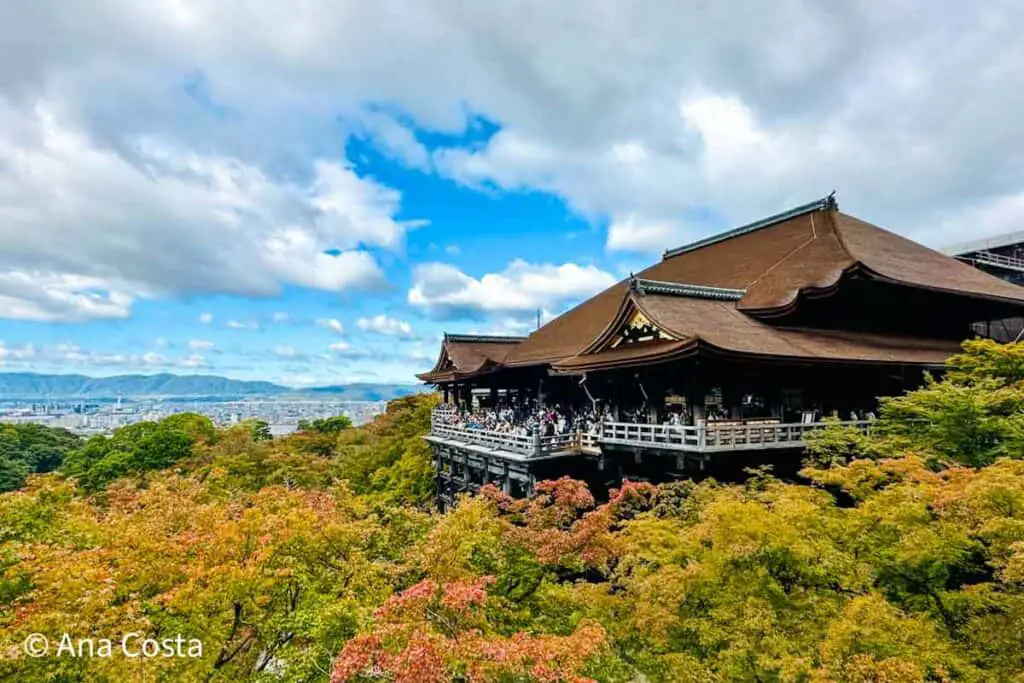
Kiyomizu-dera Temple is one of Kyoto’s most famous landmarks. It’s renowned for its huge wooden stage where you have panoramic views of the city. The temple is particularly beautiful during the cherry blossom and autumn foliage seasons. Kiyomizu-dera is a UNESCO World Heritage site that attracts visitors with its natural beauty and traditional architecture.
- Location: 1 Chome-294 Kiyomizu, Higashiyama Ward, Kyoto, 605-0862, Japan
- Highlights: The iconic Kiyomizu Stage and views of Kyoto, especially during cherry blossom season.
- Entry Fee: Free for the outer grounds.
- How to Get There: Take the Kyoto City Bus (routes 100 or 206) to Gojo-zaka or Kiyomizu-michi bus stop. The temple is a 10-minute uphill walk from there.
- Best Pass: Kyoto City Bus & Kyoto Bus One-Day Pass (around ¥1,100).
- Pro Tip: Try to visit during the cherry blossom season (late March to early April) or autumn foliage (November) for stunning views of the temple framed by nature.
- Useful Website: Kiyomizu-dera
8. Zojo-ji Temple (Tokyo)
The Zojo-ji Temple, next to Tokyo Tower, is a Buddhist temple with important historical roots. The contrast between the ancient temple and the modern Tokyo skyline makes it a popular destination for both locals and tourists. Zojo-ji is also a symbol of resilience and peace. It has the graves of many Tokugawa shoguns.
- Location: 4 Chome-7-35 Shibakoen, Minato City, Tokyo 105-0011, Japan
- Highlights: The temple’s ancient cemetery, the contrast with Tokyo Tower, and historical significance.
- Entry Fee: Free.
- How to Get There: Take the Toei Oedo Line to Daimon Station or the JR Yamanote Line to Hamamatsucho Station. The temple is a 10-minute walk from either station.
- Best Pass: Tokyo Subway Ticket (from ¥800). Buy the Tokyo Subway Ticket here.
- Pro Tip: After visiting the temple, take a short walk to Tokyo Tower for panoramic views of the city.
- Useful Website: Zozo-ji
9. Hida Kokubun-ji Temple (Takayama)
Hida Kokubun-ji Temple is Takayama’s oldest temple. It is known for its ancient three-story pagoda and a thousand-year-old ginkgo tree. It’s a nice and quiet spot that shows the area’s rich history and Buddhist traditions. People who visit Takayama’s old town should definitely check it out.
Dreaming of Japan? Here’s your go-to guide for a great trip.
Download Free Guide
- Location: 1 Chome-83 Sowamachi, Takayama, Gifu 506-0007, Japan
- Highlights: The old wooden pagoda, quiet gardens, and traditional architecture.
- Entry Fee: Free.
- How to Get There: The temple is a 5-minute walk from JR Takayama Station.
- Best Pass: JR Takayama-Hokuriku Area Tourist Pass (from ¥19,800 for 5 days) – Covers unlimited travel on JR trains between Nagoya, Takayama, and Kanazawa, and between Kansai Airport and Kanazawa (Osaka and Kyoto too). Buy the Takayama-Hokuriku Area Tourist Pass here.
- Pro Tip: Combine your visit to the temple with a stroll through Takayama’s old town, famous for its well-preserved Edo-period streets.
- Useful Website: Hida Kokubun-ji (Japanese)
10. Kasuga Taisha Shrine (Nara)
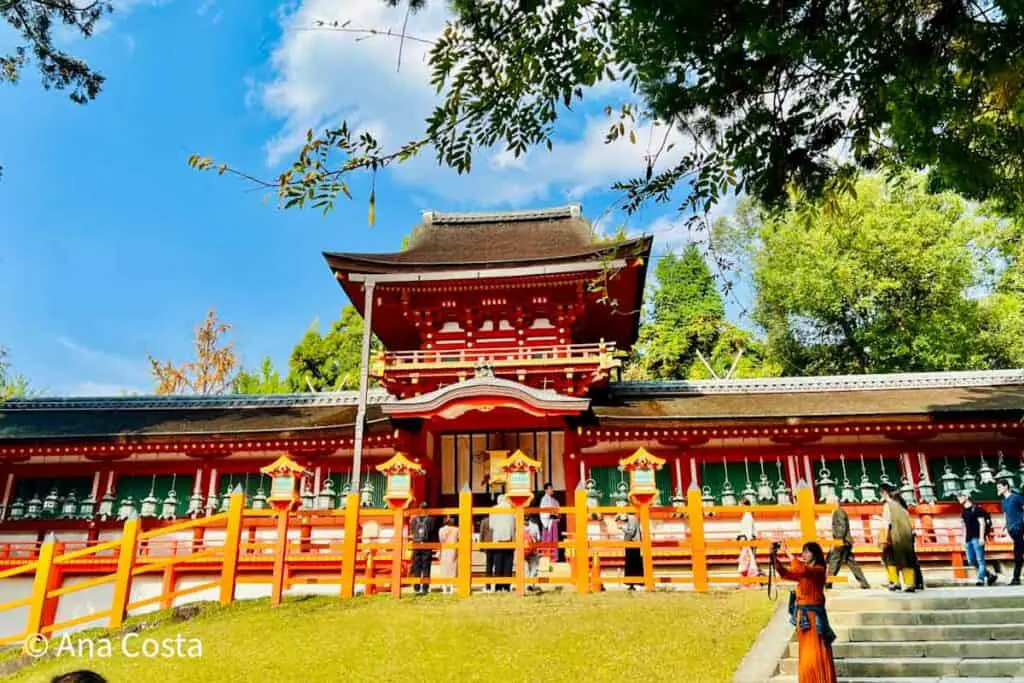
Located in Nara Park, the Kasuga Taisha Shrine is famous for its hundreds of bronze and stone lanterns.These lanterns are usually lit during special festivals. The shrine is dedicated to the deity responsible for protecting Nara. When visiting the city’s vast park, where you can see the roaming deer and other cultural sites, make sure you check out this incredible shrine too.
- Location: 160 Kasuganocho, Nara, 630-8212, Japan
- Highlights: Hundreds of stone lanterns, deer wandering nearby, and a peaceful atmosphere.
- Entry Fee: Free for outer grounds.
- How to Get There: From Nara Station, take the Nara Kotsu Bus to Kasuga Taisha Honden bus stop. The shrine is a short walk from there.
- Best Pass: JR Kansai Area Pass (from ¥2,800 for 1 day) – Unlimited rides on special rapid services, rapid services, and local trains on JR West lines between Kansai Airport, Kyoto, Osaka, Nara, Wakayama, Kobe, and Himeji. Buy the Kansai Area Pass here.
- Pro Tip: Don’t miss the nearby Nara Park, where you can feed and interact with the famous deer.
- Useful Website: Kasuga Taisha
11. Heian Shrine (Kyoto)
Heian Shrine is a large shrine with a towering torii gate and beautiful gardens. It was built to commemorate the 1,100th anniversary of Kyoto’s founding, ans it is a picturesque spot for photographers. It’s particularly popular for its beauty during the cherry blossom and the autumn foliage season.
- Location: 97 Okazaki Nishitennocho, Sakyo Ward, Kyoto, 606-8341, Japan
- Highlights: The towering red torii gate and open shrine courtyard.
- Entry Fee: Free (Note: Garden has a fee).
- How to Get There: Take the Kyoto City Bus (routes 5 or 100) to Kyoto Kaikan Bijutsukan-mae bus stop. The shrine is a 5-minute walk away.
- Best Pass: Kyoto City Bus & Kyoto Bus One-Day Pass (around ¥1,100).
- Pro Tip: Visit the Heian Shrine during the Jidai Matsuri in October, when a grand historical parade passes through the shrine grounds.
- Useful Website: Heian Jingu
12. Tsurugaoka Hachimangu Shrine (Kamakura)
Tsurugaoka Hachimangu is the most important shrine in Kamakura, and it’s dedicated to Hachiman, the god of warriors. The shrine attracts visitors interested in nature and history, and it’s a great place for those exploring Kamakura’s cultural heritage.
- Location: 2 Chome-1-31 Yukinoshita, Kamakura, Kanagawa 248-8588, Japan
- Highlights: Panoramic views of Kamakura, the grand staircase, and nearby hiking trails.
- Entry Fee: Free.
- How to Get There: From Tokyo, take the JR Yokosuka Line to Kamakura Station. The shrine is a 10-minute walk from the station.
- Best Pass: Kamakura-Enoshima FreePass (around ¥1,640 for 1 day) – Unlimited travel on JR and Enoden lines in the Kamakura area.
- Pro Tip: Time your visit to catch a glimpse of the seasonal flowers blooming along the shrine’s approach.
- Useful Website: Tsurugaoka Hachimangu
13. Sumiyoshi Taisha (Osaka)
Sumiyoshi Taisha is a very important shrine in Osaka. It’s dedicated to the Sumiyoshi gods who protect travelers and sailors. The shrine is famous for its unique architectural style, and its iconic red Sorihashi Bridge.
- Location: Chome-9-89 Sumiyoshi, Sumiyoshi Ward, Osaka, 558-0045, Japan
- Highlights: The beautiful Sorihashi Bridge and ancient architecture.
- Entry Fee: Free.
- How to Get There: Take the Nankai Main Line to Sumiyoshi Taisha Station or the Hankai Tramway to Sumiyoshitoriimae Station. The shrine is a 5-minute walk from either station.
- Best Pass: Osaka Amazing Pass (around ¥3,300 for 1 day) – Unlimited subway, tram, and bus rides, plus free entry to selected attractions. Buy the Osaka Amazing Pass here.
- Pro Tip: Visit the Sumiyoshi Taiko Bridge, one of the shrine’s most photogenic spots, particularly during the New Year when many locals come to pray.
- Useful Website: Sumiyoshi Taisha

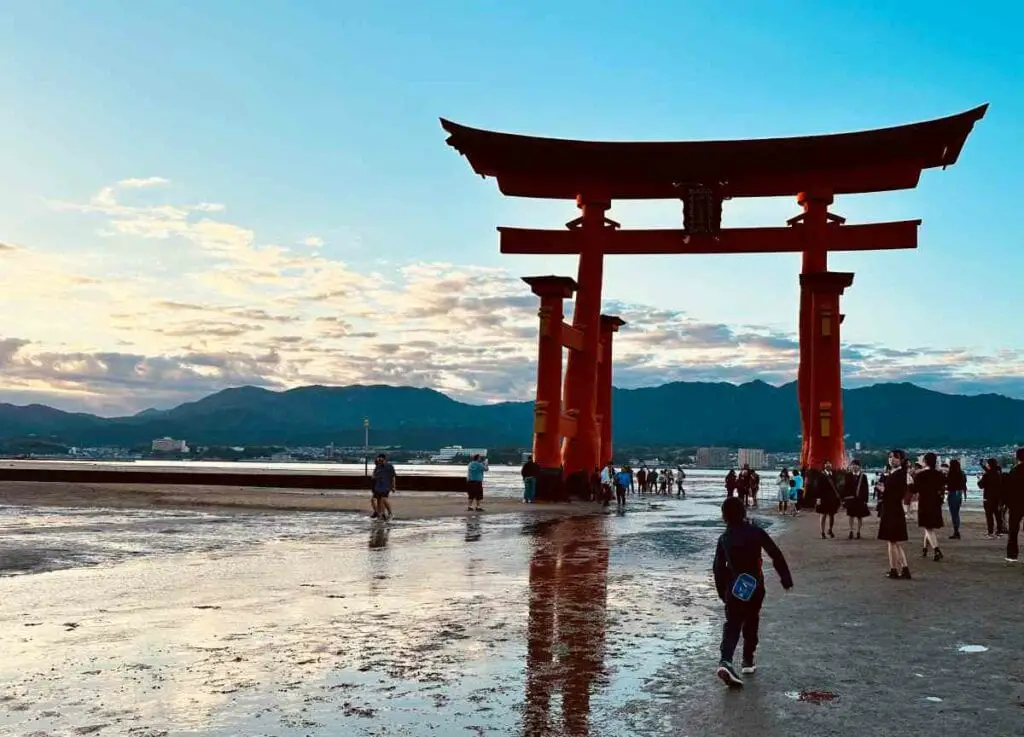
![[Easy Guide] How To Explore Japan Without Speaking Japanese](https://japanhorizon.com/wp-content/uploads/2021/04/kanji-1024x553.jpg)
